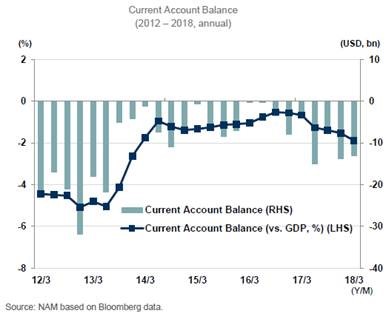Emerging Markets
India's Equities Are Promising Long-Term Prospect - Nomura

A correction in the Indian stock market should be an opportunity for investors to get into the game, given positive longer term economic prospects.
India’s economic growth prospects are positive in the long term
but markets have been buffeted by headwinds recently, and falls
in prices give investors a chance to get into the market,
according to Nomura Asset
Management.
“India has delivered the fastest economic growth among the larger
countries, and we expect this trend to continue into the medium-
to long-term. In addition to demographic advantages, a primary
factor, policy contributions such as political reforms and
efforts to resolve non-performing bank loan problems are also
contributing to its strength,” Vipul Mehta, head of investment,
said.
“However, in the most recent six months, there have also been
some short-term head winds, such as the current account deficit,
which has expanded along with the rise in oil prices and an
outflow of funds from emerging markets as a whole caused by
rising long-term interest rates in the US,” Mehta said, adding:
“Under such circumstances, for longer term investors, a
short-term correction is considered to be a good opportunity to
purchase Indian shares at a reasonable price.”
So far this year, the MSCI India index of equities is down 0.6
per cent, when measured in dollars. That contrasts with the 8.26
per cent fall in the wider MSCI Emerging Market index.
Nomra’s Mehta said domestic demand expansion and infrastructure
developments are its main investment themes, focusing on
"financial services for individuals (banks, insurance, investment
trusts)“, “daily necessities“, "capital goods“, and "general
consumer goods".
Among near-term headwinds to growth is a widening current account
deficit.

“India is highly dependent on oil imports, so the trade balance
has deteriorated due to the recent rise in oil prices. Exports
are sluggish as well, having missed a ride on the wave of
worldwide trade volume expansion. The manufacturing industry
appears to be one of India's fundamental weaknesses. Due to this
rise in the current account deficit, there is substantial
downward pressure on the rupee in the short term. However, this
cloudy immediate outlook does have a silver lining,” Mehta
said.
Indian authorities has intervened to buy rupee due to abundant
foreign exchange reserves, which have increased by approximately
$100 billion over the last five years, leaving plenty of scope
for further interventions. A positive move has been a policy rate
hike by the Indian central bank, the investment firm said.
“Although we have outlined the market risks associated with the
rupee, we also think the investment environment in India presents
many positive features, even in the short term,” Mehta said. “For
example, corporate earnings, where earnings for Jan - Mar 2018
were generally good. Unlike last year when there was a temporary
decline due to the introduction of goods and services tax (GST);
this year we expect an earnings per share growth rate of
approximately 15 per cent,” he continued.
Mehta said there remains a continuous steady inflow of capital
from domestic investors.